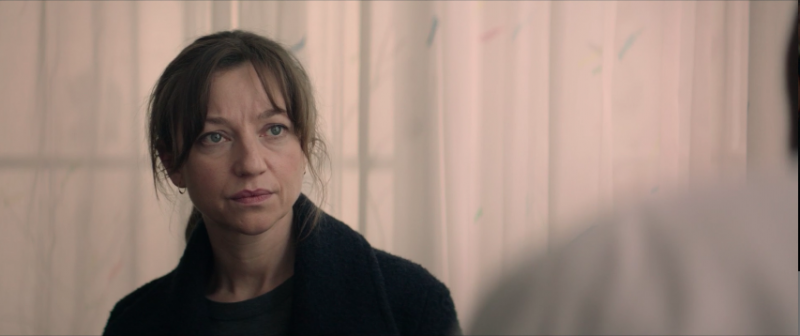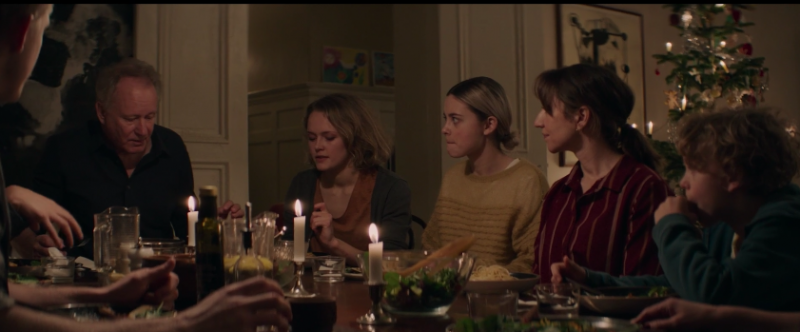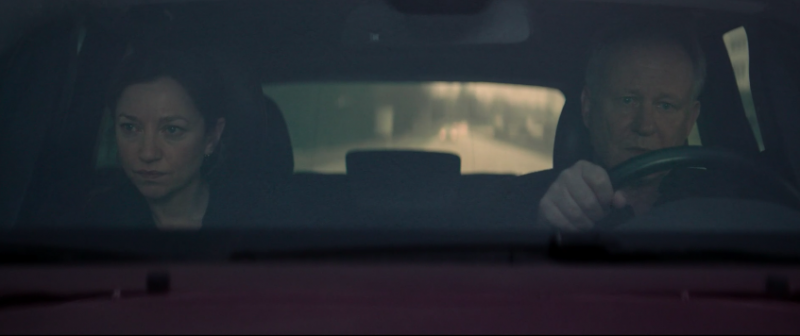
J’ai eu la chance d’assister à Camerimage l’an dernier en « présenciel ». Et à Camerimage, on sait que l’on peut voir des films « Nordiques »…
Dans la jolie ville de Toruń aussi le vent nous glace, la nuit tombe à 16h00 mais on peut toujours compter sur la chaleur des cafés : ce qui nous manque aujourd’hui ! Alors j’ai voulu choisir un film Norvégien…
Hope est le nouveau film de la réalisatrice norvégienne Maria Sødahl, après Limbo, son premier film. Son directeur de la photographie, Manuel Alberto Claro DFF, est d’origine chilienne et a grandi au Danemark. Il a travaillé entre autre avec Lars von trier sur « Melancholia » et sur le premier film de Maria Sødahl.
Après avoir été récompensé aux Berlinales 2020, Hope vient d’être sélectionné pour représenter la Norvège aux oscars.
Le scénario, écrit par la réalisatrice, est inspiré de sa propre histoire, celle d’une femme à qui l’on découvre une tumeur au cerveau incurable, un an après avoir eu un cancer aux poumon. Le film se déroule durant la période de Noël et des fêtes de fin d’année en Norvège. Le personnage principal, Anja, affronte la maladie mais se confronte aussi à sa vie avec son conjoint et ses enfants.
Le film s’appelle Hope, mais en fait Anja n’a aucun espoir, le seul espoir résidant dans le titre du film.



Entre Noël et le jour de l’an, le compte à rebours de la maladie nous tient en haleine, « comme pour fatiguer le spectateur », explique la réalisatrice. Mais il y a aussi ces moments hors du temps où les personnages sont comme dans une bulle, lorsqu’ils sont dans leur chambre ou dans leur voiture.
Hope parle profondément d’amour : comment en donner et en recevoir, comment le temps peut à la fois user ou au contraire décupler l’amour.
C’est aussi un film sur les femmes et les hommes engagés dans leur vie intime, familiale et professionnelle. Comment la vie quotidienne, le travail, peut nous amener à nous éloigner les uns des autres. Il y a beaucoup d’émotion malgré une certaine retenue, une atmosphère dramatique qui ne tombe pas dans le mélodrame. C’est bien là tout le talent de la réalisatrice que d’arriver à traiter de sujets aussi graves que la maladie ou la mort, en toute simplicité… Un film sombre ne vaut pas forcément dire une ambiance froide, comme l’indique Maria Sødahl : de fait le film a été tourné dans une atmosphère plutôt détendue et chaleureuse.
Le « sombre » est cependant présent dans l’image du film par le jeu du contraste, par la profondeur des noirs, y compris dans les intérieurs, qui sert le propos du film.
Il y a aussi une envie d’appuyer l’ambivalence des sentiments des personnages, entre le chaud des guirlandes et des bougies dans les intérieurs et le froid nordique du dehors, notamment les scènes sous la pluie en extérieur, qui égratignent le coté féerique de Noël.



La caméra, souvent cadrée à l’épaule, nous plonge aisément dans l’intimité des personnages, comme un regard incarné et profond peut déceler l’intime, loin de l’impudeur du voyeurisme. Il y a aussi une volonté de laisser beaucoup d’espace aux comédiens, sans artifice, comme le dit Manuel Alberto Claro.
Le film a aussi été minutieusement préparé pour arriver à un réalisme et un naturalisme très puissant dans un appartement recréé en studio.
Cette préparation du décor s’est aussi prolongée par une liste de plans précise (et respectée!) et de nombreuses répétitions sur le plateau, de sorte que la réalisatrice pouvait se consacrer exclusivement à la mise en scène avec les comédiens (Andrea Bræin Hovig et Stellan Skarsgård, remarquables) tout en faisant une confiance totale à son directeur photo.
De la maîtrise et de la précision, donc, pour pouvoir filmer la réalité fragile d’une famille au point de bascule.
« Fallait-il vraiment qu’une peine de mort ait lieu pour que tu fasses ce qu’il faut, quand tout était déjà fini ? » dit Anja à Thomas dans le film.

Le film a été tourné en Alexa Mini poussée à 1600 IS0 avec une série Hawk Lite Anamorphic. Le tournage a duré 6 semaines dont 3 en Studio. Le décor de l’appartement est éclairé principalement avec des entrants et des lumières de jeux, avec en appoint quelques Litemate 2 ou 4 et parfois des Dedolight.
VERSION ANGLAISE
I had the chance to attend Camerimage last year in the flesh. When we go to Camerimage, we know we’ll be able to see Nordic films. A kind of mood we can get also in the picturesque town of Toruń, with its chilling wind, 4PM nightfalls that drive us to the warmth of the cafés… We miss it all.
So for this year’s virtual edition, I was willing to see a Norwegian film.
Hope is Norwegian director Maria Sødahl’s latest effort after Limbo, her first film.
Hope’s Cinematographer, Manuel Alberto Claro DFF, is of Chilean decent and grew up in Denmark. He worked with Lars von trier on « Melancholia » and shot Limbo, among others.
After winning an award at the Berlinale 2020, Hope has just been selected to represent Norway at the Oscars.
The screenplay, written by the director, has an autobiographical basis, about a woman who is diagnosed with an incurable brain tumor a year after having lung cancer. The film takes place during the Christmas holidays and is set in Norway. Anja, the protagonist, battles the disease but also wrestles with her life with her husband and children.
The film is called Hope, but in fact Anja is hope-less, the hope residing solely in the film’s title.



Between Christmas and New Year’s Day, the disease’s ominous countdown keeps us on tenterhooks, « as if to tire out the viewer, » explains the director. But there are also those lapses of time when the characters seem trapped in a bubble, within their room or their car.
Hope speaks deeply about love : how to give and receive it, how time can both wear it down and amplify love tenfold.
It is also a film about women and men involved in their intimacy, family and professional lives. How daily life, work, can lead us to distance ourselves from each other. There’s a lot of emotion despite a certain restraint, a dramatic atmosphere that doesn’t fall into melodrama. That’s the director’s talent : to deal with such serious subjects as illness or death in such a simple way…
A dark film is not necessarily a cold film, says Maria Sødahl : in fact the film was shot in a rather relaxed, warm atmosphere.
The « darkness » is, however, present in the film’s image which plays on contrast, with deep blacks, particularly in the interiors, in service of the film.
There’s also a clear desire to underscore the ambivalence of the characters’ feelings, contrasting the warmth of the Christmas lights and candles in the interiors with the Nordic cold outside, especially in rain soaked exterior scenes, which erode the fairytale image of Christmas.



The camera is often handheld, immersing us in the characters’ intimacy, offering an embodied, deep gaze to detect the intimate, far from the shamelessness of voyeurism. There’s also a willingness to leave a lot of space for the actors, without artifice, as Manuel Alberto Claro says.
The film has also been meticulously prepared to achieve a very powerful realism and naturalism in an apartment recreated in studio.
This preparation continued through a precisely conceived (and executed!) shot list and numerous rehearsals on the set, so that the director could devote herself exclusively to directing the actors (Andrea Bræin Hovig and Stellan Skarsgård, remarkable) while having total confidence in her director of photography.
Mastery and precision, therefore, for filming the fragile reality of a family at the tipping point.
« Did you really have to have the death penalty for you to do the right thing when it was already over, » Anja tells Thomas in the film.

The film was shot on an Arri Alexa Mini pushed to 1600 ISO using Hawk Lite Anamorphics. The shoot lasted six weeks, three of which were spent in the studio. The apartment set is lit mainly with inlets and practicals with a few Litemate 2s or 4s and sometimes Dedolights.
-
Partager l'article


